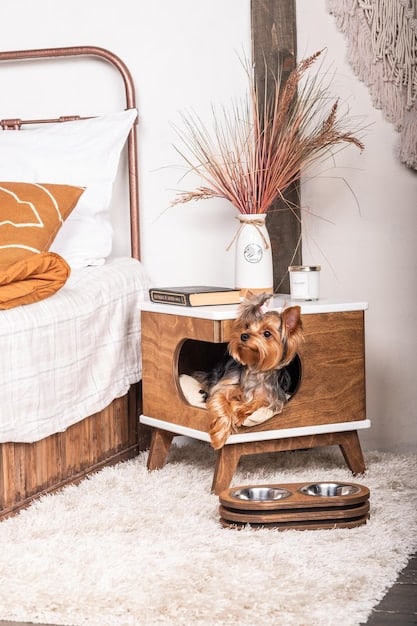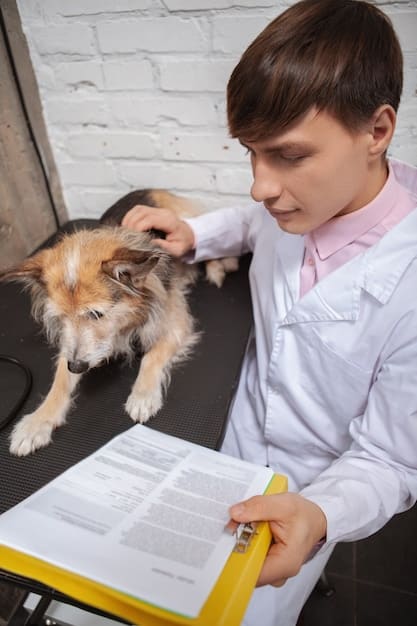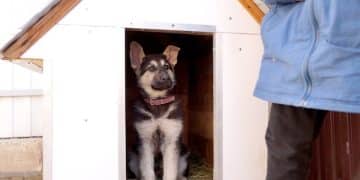Separation Anxiety in Dogs: A Step-by-Step Plan for 2025

Anúncios
Separation anxiety in dogs is a distressful condition where dogs exhibit anxiety when left alone, which can be managed through a structured plan involving desensitization exercises, environmental enrichment, and consistent training techniques aimed at reducing their dependence and fear by 2025.
Does your furry friend panic when you leave the house? You’re not alone. Separation anxiety in dogs: A step-by-step plan to reduce distress by 2025 focuses on practical, actionable strategies to help your canine companion cope with being alone, ensuring they feel safe and secure even in your absence.
Anúncios
Understanding Separation Anxiety in Dogs
Separation anxiety is more than just a dog missing its owner. It’s a serious behavioral issue that can manifest in destructive behaviors, excessive barking, and even physical distress. Understanding the root causes and symptoms is the first step in helping your dog overcome this challenge.
Let’s delve into the common triggers and signs of separation anxiety so you can better identify if your dog is struggling.
Anúncios
Common Triggers for Separation Anxiety
Several factors can trigger separation anxiety in dogs, making it crucial to understand these triggers to manage and minimize the anxiety.
- Change in Routine: A sudden shift in the daily schedule, such as a new work schedule or moving to a new home, can unsettle a dog.
- Loss of a Family Member: The absence of a human or animal companion can lead to feelings of loneliness and anxiety.
- Traumatic Experiences: Events like loud storms or nearby construction can create fear and anxiety associated with being alone.
Recognizing the Signs of Distress
Identifying the signs of separation anxiety is vital for providing timely support and intervention. Common symptoms include:
- Destructive Behavior: Chewing furniture, scratching doors, or destroying personal items.
- Excessive Vocalization: Constant barking, howling, or whining when left alone.
- Inappropriate Elimination: Urinating or defecating indoors despite being house-trained.
- Pacing and Panting: Restlessness and heavy breathing as a sign of stress.
By recognizing these triggers and signs, you can start to develop a plan to address your dog’s separation anxiety effectively. Remember, patience and consistency are essential in this process.
Creating a Safe and Comfortable Environment
A secure and comforting environment can significantly reduce your dog’s anxiety levels. This involves creating a space where your dog feels safe and relaxed, even when you’re not around.
Here’s how to set up a calming sanctuary for your furry friend.
Designating a “Safe Zone”
Establish a specific area in your home as your dog’s safe zone. This could be a crate, a bed in a quiet room, or any spot where your dog feels most comfortable.
Enriching the Environment with Toys and Comfort Items
Provide plenty of engaging toys and familiar items to keep your dog occupied and comforted.
- Puzzle Toys: These challenge your dog mentally and provide a rewarding distraction.
- Comfort Items: Include items with your scent, such as an old t-shirt or blanket, to provide a sense of security.
- Interactive Toys: Toys that dispense treats or require interaction can keep your dog entertained.
By creating a safe and stimulating environment, you can help reduce your dog’s anxiety and improve their overall well-being. This is a crucial step in addressing separation anxiety and promoting a sense of security.

Implementing Desensitization Techniques
Desensitization is a gradual process that helps your dog become accustomed to being alone without experiencing anxiety. This involves slowly increasing the duration of your absences while monitoring your dog’s behavior.
Let’s explore some effective desensitization exercises you can implement at home.
Practicing Short Absences and Gradual Increases
Start with very short absences, such as leaving the room for a few seconds, and gradually increase the time as your dog becomes more comfortable. The key is to avoid triggering anxiety during these exercises.
Using Cues and Signals to Prepare Your Dog
Establish cues or signals that indicate you are leaving but will return. This helps your dog anticipate your departure without feeling overwhelmed.
Desensitization techniques require patience and consistency. It’s important to monitor your dog’s behavior closely and adjust the pace of the exercises as needed. With time and practice, your dog can learn to tolerate being alone without experiencing excessive anxiety.
Training and Counterconditioning
Training and counterconditioning are essential components of a comprehensive plan to address separation anxiety in dogs. These techniques help change your dog’s emotional response to being alone, turning a negative experience into a positive one.
Let’s examine some key training and counterconditioning strategies.
Teaching a “Stay” Command
The “stay” command can provide your dog with a sense of structure and control during brief absences. Start by teaching your dog to stay in a specific location for short periods, gradually increasing the duration.
Associating Your Departure with Positive Reinforcement
Counterconditioning involves associating your departure with something positive, such as a special treat or toy. This helps create a positive emotional response to being alone.
- Offer a High-Value Treat: Give your dog a treat they only receive when you leave.
- Use a Special Toy: Provide an engaging toy that keeps your dog occupied during your absence.
By consistently implementing these training and counterconditioning techniques, you can help your dog develop a more positive association with being alone, reducing their anxiety and improving their overall well-being.
Medication and Professional Help
In some cases, separation anxiety may require medical intervention or professional assistance. If your dog’s anxiety is severe or unresponsive to training and behavioral modifications, consulting with a veterinarian or a certified dog behaviorist is crucial.
Here’s when and how to seek additional help.
When to Consider Medication
Medication may be considered if your dog’s anxiety is significantly impacting their quality of life or if behavioral interventions alone are not sufficient.
Consulting with a Veterinarian or Behaviorist
A veterinarian can assess your dog’s overall health and prescribe appropriate medication if necessary. A certified dog behaviorist can provide specialized training and support to address the underlying causes of separation anxiety. Look for professionals certified by reputable organizations such as the Certification Council for Professional Dog Trainers (CCPDT) or the International Association of Animal Behavior Consultants (IAABC).

The Role of Ongoing Support and Patience
Addressing separation anxiety requires a long-term commitment and a supportive approach. Celebrate small victories, be patient with setbacks, and remember that every dog progresses at their own pace. Consistency and understanding are key to helping your dog overcome separation anxiety and live a happier, more relaxed life.
Preventing Relapse and Maintaining Progress
Once your dog has made progress in overcoming separation anxiety, it’s important to maintain that progress and prevent relapse. This involves continuing the strategies and techniques that have been successful, as well as monitoring your dog’s behavior for any signs of regression.
Here are some key strategies for maintaining progress and preventing relapse:
- Consistency in Routine: Maintain a consistent daily schedule to provide stability and predictability for your dog.
- Ongoing Training and Enrichment: Continue to provide training exercises and engaging activities to keep your dog mentally stimulated and reduce anxiety.
- Early Intervention: If you notice any signs of increased anxiety, address them promptly with proven techniques.
By implementing these strategies, you can help your dog maintain their progress and prevent relapse, ensuring they continue to enjoy a life free from separation anxiety. Remember, a proactive approach and consistent support are essential for long-term success.
By understanding these core concepts, you can take meaningful steps to address and alleviate anxiety in your canine companion by 2025.
| Key Point | Brief Description |
|---|---|
| 🔑 Understanding Triggers | Identify causes like routine changes or noise sensitivity. |
| 🏡 Safe Environment | Create a safe space with familiar items for comfort. |
| 🐾 Desensitization | Gradually increase alone time to reduce anxiety. |
| 💊 Professional Help | Consider medication or a behaviorist for severe cases. |
FAQ
▼
Common symptoms include destructive behavior, excessive barking, inappropriate elimination, pacing, and panting. These signs typically manifest when the dog is left alone or anticipates being left alone.
▼
Designate a safe zone, such as a crate or quiet room, and provide comfort items like familiar blankets and toys. Puzzle toys can also help keep your dog mentally stimulated and less anxious.
▼
Desensitization involves gradually exposing your dog to the trigger (being alone) in small increments. Start with short absences and slowly increase the time, ensuring your dog remains calm throughout the process.
▼
Consider medication if behavioral interventions are not sufficient, or if your dog’s anxiety significantly impacts their quality of life. Consult with a veterinarian for a thorough assessment and guidance.
▼
Maintain a consistent routine, continue providing training and enrichment, and promptly address any signs of increased anxiety. Regular check-ins with your veterinarian can also help monitor your dog’s progress.
Conclusion
Addressing separation anxiety in dogs requires patience, consistency, and a holistic approach that includes environmental enrichment, training, and, when necessary, professional medical advice. By implementing the strategies outlined in this guide, you can help your furry friend overcome their anxiety and enjoy a happier, more relaxed life by 2025.






